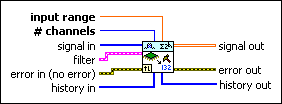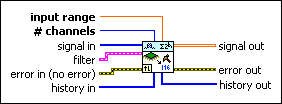DFD FXP Postprocessing VI
Owning Palette: Fixed-Point Tools VIs
Installed With: Digital Filter Design Toolkit
Converts the output signal of a fixed-point filter from a fixed-point integer representation to a floating-point representation. You must manually select the polymorphic instance you want to use.
Use the pull-down menu to select an instance of this VI.
 Place on the block diagram Place on the block diagram |  Find on the Functions palette Find on the Functions palette |
DFD FXP Postprocessing (I32, nCh)

 | input range specifies the maximum absolute value of the input signal that the fixed-point integer can represent. For example, the input ranges both are 10 for DAQ devices with ranges of [0, 10V] and [–10, 10V]. The default is 1. | ||||||
 | # channels specifies the number of channels that signal in contains. The default is 1. | ||||||
 | signal in specifies the input signal that you want to process. | ||||||
 | filter specifies the input filter. | ||||||
 | error in describes error conditions that occur before this VI or function runs.
The default is no error. If an error occurred before this VI or function runs, the VI or function passes the error in value to error out. This VI or function runs normally only if no error occurred before this VI or function runs. If an error occurs while this VI or function runs, it runs normally and sets its own error status in error out. Use the Simple Error Handler or General Error Handler VIs to display the description of the error code. Use error in and error out to check errors and to specify execution order by wiring error out from one node to error in of the next node.
| ||||||
 | history in specifies the data from the last iteration of the postprocessing process. | ||||||
 | signal out returns a floating-point signal after postprocessing signal in. | ||||||
 | error out contains error information. If error in indicates that an error occurred before this VI or function ran, error out contains the same error information. Otherwise, it describes the error status that this VI or function produces.
Right-click the error out front panel indicator and select Explain Error from the shortcut menu for more information about the error.
| ||||||
 | history out returns the remaining data for the next iteration of postprocessing. You can wire this output to the history in input of the next call to this VI if you want to process the data continuously. |
DFD FXP Postprocessing (I16, nCh)

 | input range specifies the maximum absolute value of the input signal that the fixed-point integer can represent. For example, the input ranges both are 10 for DAQ devices with ranges of [0, 10V] and [–10, 10V]. The default is 1. | ||||||
 | # channels specifies the number of channels that signal in contains. The default is 1. | ||||||
 | signal in specifies the input signal that you want to process. | ||||||
 | filter specifies the input filter. | ||||||
 | error in describes error conditions that occur before this VI or function runs.
The default is no error. If an error occurred before this VI or function runs, the VI or function passes the error in value to error out. This VI or function runs normally only if no error occurred before this VI or function runs. If an error occurs while this VI or function runs, it runs normally and sets its own error status in error out. Use the Simple Error Handler or General Error Handler VIs to display the description of the error code. Use error in and error out to check errors and to specify execution order by wiring error out from one node to error in of the next node.
| ||||||
 | history in specifies the history data from the last iteration of postprocessing. | ||||||
 | signal out returns a floating-point signal after postprocessing signal in. | ||||||
 | error out contains error information. If error in indicates that an error occurred before this VI or function ran, error out contains the same error information. Otherwise, it describes the error status that this VI or function produces.
Right-click the error out front panel indicator and select Explain Error from the shortcut menu for more information about the error.
| ||||||
 | history out returns the remaining data for the next iteration of postprocessing. You can wire this output to the history in input of the next call to this VI if you want to process the data continuously. |
DFD FXP Postprocessing (I32, 1Ch)

 | input range specifies the maximum absolute value of the input signal that the fixed-point integer can represent. For example, the input ranges both are 10 for DAQ devices with ranges of [0, 10V] and [–10, 10V]. The default is 1. | ||||||
 | signal in specifies the input signal that you want to process. | ||||||
 | filter specifies the input filter. | ||||||
 | error in describes error conditions that occur before this VI or function runs.
The default is no error. If an error occurred before this VI or function runs, the VI or function passes the error in value to error out. This VI or function runs normally only if no error occurred before this VI or function runs. If an error occurs while this VI or function runs, it runs normally and sets its own error status in error out. Use the Simple Error Handler or General Error Handler VIs to display the description of the error code. Use error in and error out to check errors and to specify execution order by wiring error out from one node to error in of the next node.
| ||||||
 | signal out returns a floating-point signal after postprocessing signal in. | ||||||
 | error out contains error information. If error in indicates that an error occurred before this VI or function ran, error out contains the same error information. Otherwise, it describes the error status that this VI or function produces.
Right-click the error out front panel indicator and select Explain Error from the shortcut menu for more information about the error.
|
DFD FXP Postprocessing (I16, 1Ch)

 | input range specifies the maximum absolute value of the input signal that the fixed-point integer can represent. For example, the input ranges both are 10 for DAQ devices with ranges of [0, 10V] and [–10, 10V]. The default is 1. | ||||||
 | signal in specifies the input signal that you want to process. | ||||||
 | filter specifies the input filter. | ||||||
 | error in describes error conditions that occur before this VI or function runs.
The default is no error. If an error occurred before this VI or function runs, the VI or function passes the error in value to error out. This VI or function runs normally only if no error occurred before this VI or function runs. If an error occurs while this VI or function runs, it runs normally and sets its own error status in error out. Use the Simple Error Handler or General Error Handler VIs to display the description of the error code. Use error in and error out to check errors and to specify execution order by wiring error out from one node to error in of the next node.
| ||||||
 | signal out returns a floating-point signal after postprocessing signal in. | ||||||
 | error out contains error information. If error in indicates that an error occurred before this VI or function ran, error out contains the same error information. Otherwise, it describes the error status that this VI or function produces.
Right-click the error out front panel indicator and select Explain Error from the shortcut menu for more information about the error.
|
Example
Refer to the Simulation with Integer Inputs VI in the labview\examples\Digital Filter Design\Fixed-Point Filters\Single-Rate directory for an example of using the DFD FXP Postprocessing VI.




